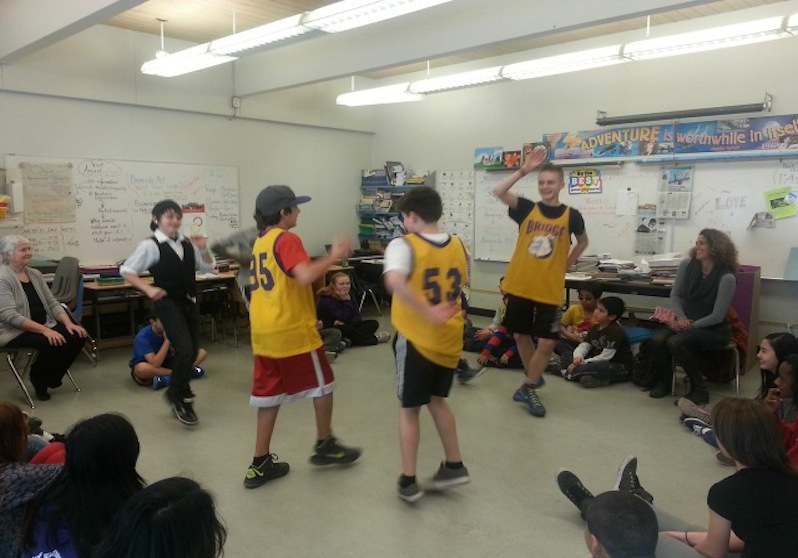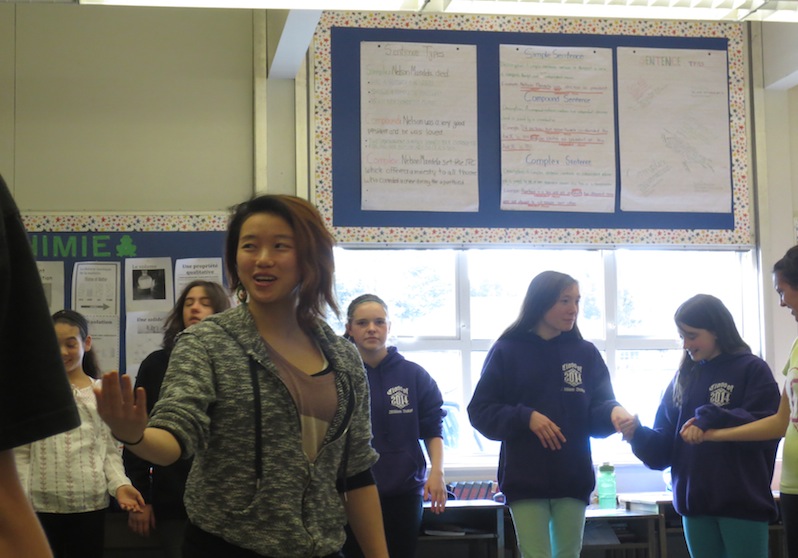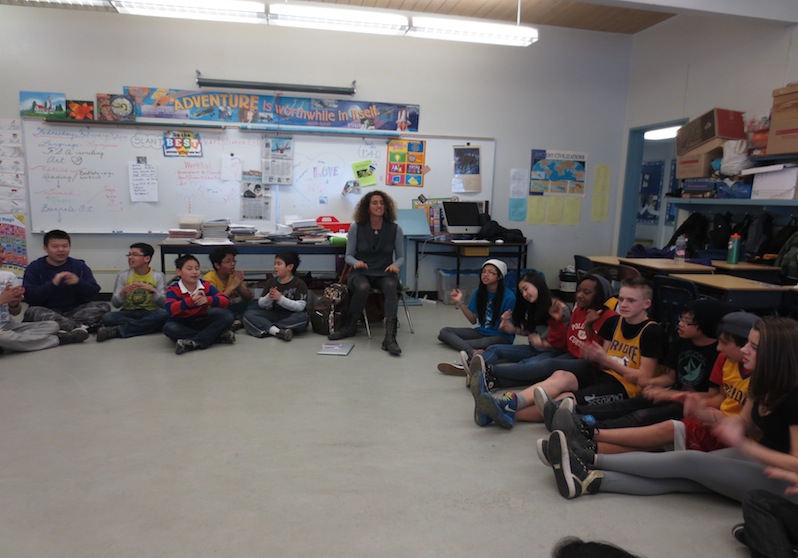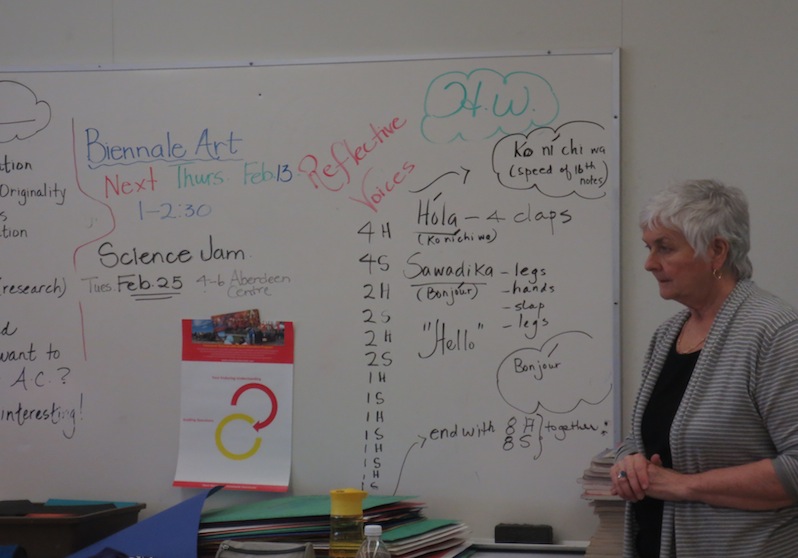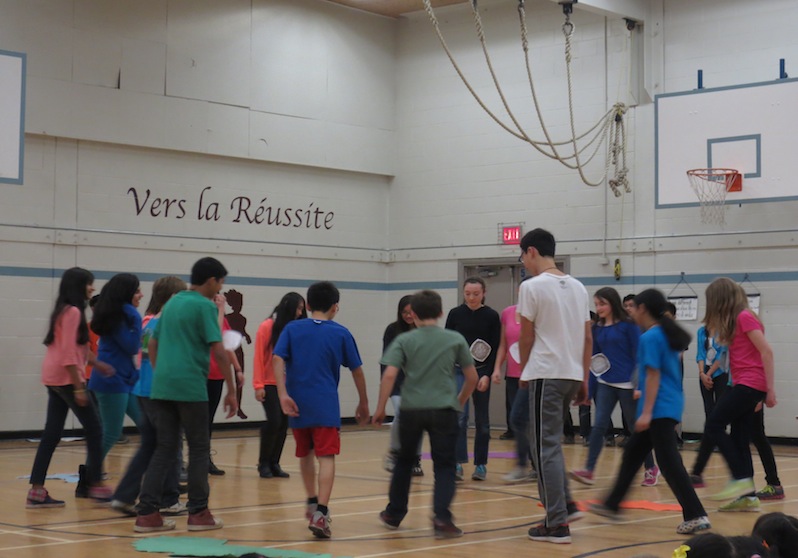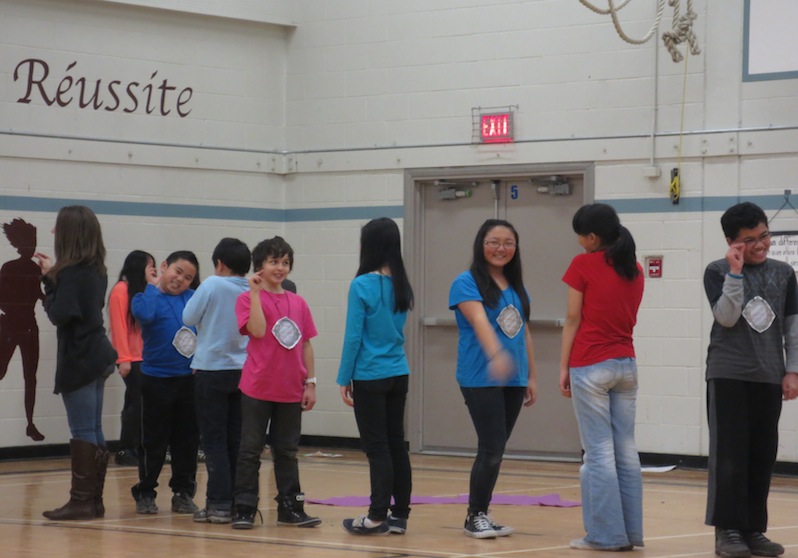William Bridge Gr 7
Arts Education, Health and Career Education, Language Arts, Mathematics, Social Studies
School:
William Bridge Elementary, Richmond, BC
Teachers:
Janice Potter and Deanna Trewin
Artists:
Laura Barron
Natalie Gan
Class:
Two Grade 7 classes
Connection to the Vancouver Biennale Exhibition:
Vancouver Biennale 2009-2011 Exhibition: We, 2008 (Jaume Plensa, Spain) – Students took inspiration from the multilingual writing that makes up the sculpture.
The curatorial theme of the 2014-2016 Vancouver Biennale Exhibition is Open Borders / Crossroads Vancouver. This project connects to this theme in many ways:
● Students created a crossroads of communication and engagement by celebrating and sharing the many cultures of their school
● Students cross borders of communication by learning different languages and different ways of expressing culture through song and dance
● Teachers and students cross the borders of curriculum by using art, movement and song to learn about subjects in social studies and mathematics.
Other Sources of Inspiration:
● Japanese Taiko Drumming –Youth Ensemble performing athletic style of drumming.
● Indian vocal percussion (Konnokal)
● Brazilian Drumming – Bateria Samba street music
● Drakensberg Boys Choir – South African Traditional Songs
● Pat Tierney on Irish tin whistle
● Bob Marley Reggae Music – Jammin’
● Mexican folk music played on Coke bottle trumpet
● Aldrich Talonding – Filipino You Tube sensation
Dance:
● Kiritake Kanjuro- Bunraku Puppet Theatre (Japan)
● Kliptown Youth Centre Gumboot dance (South Africa)
● Shanghai Kunqu Opera (China)
● Celina Zambon-Flamenco dance (Spain)
Overview:
Inspired by the Vancouver Biennale theme Open Borders / Crossroads and the many languages in We, 2008 (Jaume Plensa, Spain), students began an exploration of diversity and communication across cultures. Students inquired into their BIG IDEAS by sharing cultural offerings from their own background and learning songs and dances from different cultures, helping them learn how to communicate with one another in mutually respectful and thoughtful ways. The results of these engagements include a colorful array of haikus, limericks, Jewish songs, Mexican dances, and original spoken word and choreographed works which they shared with their entire school in a performance titled Reflective Voices.
BIG IDEAS:
Diversity can be celebrated through mutual respect and thoughtful communication.
Guiding Questions:
How can we respect diversity by cooperating and using our individual creative voices? How can volume, expression, pace, tone and emphases foster good communication with classmates of diverse backgrounds?
Cross-Curricular Access:
Arts Education: Creating creative cultural offerings and movements in response to a variety of sounds, music, images and feelings.
Health and Career Education: Exploring strategies for attaining and maintaining physical, emotional and social health during puberty and adolescence.
Language Arts: Learning about limericks, haikus and different languages. Writing stories and spoken word poems about cultural diversity. Learning to communicate and respond to others’ needs and reactions.
Mathematics: Recognizing and utilizing patterns and musical fractions through songs and dance routines.
Social Studies: Exploring the influence of ancient societies on present day cultures through ancestry maps and cultural offerings.
Learning Process:
The project began with an exploration of the student’s individual backgrounds and cultures by doing a choreographed mapping activity of their ancestor’s birthplaces and learning different ways to greet one another in different languages and customs. The artists then introduced songs and dances over the following months that explored different languages, cultural gestures and forms of expression. Students were asked to present cultural offerings; a song, dance or poem from one of their countries of origin that they would like to share with the class. By creating dances, songs and spoken word presentations, students practiced their communication skills and explored how they as individuals could cooperate with the entire class. The students then shared their learning experience in a final performance, Reflective Voices, a celebration of the diversity of the class.
Student Creations:
Students explored how their expressive voices could reflect their individual and collectively identity by creating ancestry maps, an Irish limerick and Japanese Haikus about cultural diversity and creating their own cultural offerings to present to the class and to the school. With the help of the artists, students learnt and shaped a song based on different ways to say hello, a Mexican Hat Dance, a movement activity exploring greetings from different cultures and the Jewish song “Hava Nagila”.
Taking Action:
The students demonstrated respectful communication and listening throughout the project, learning more about each other and about their own cultural backgrounds. In order to share their learning and celebrate the diversity of their class, the students performed Reflective Voices for the entire school and community.
Project Timeline:
January:
● Introduction of Biennale project. Responding to We, 2008 (Jaume Plensa, Spain) by exploring different languages and culture specific greetings
● Choreographed mapping of ancestral roots and viewing of music/dance/literature media from the birthplace of students and their family’s birthplaces
● Theatrical activity exploring how tone/volume/emphasis in verbal communication and tension/speed/size in physicality can express thoughts and emotions
● Introduction of cultural offerings
● First lesson of greeting duets, Hello song and Mexican Hat Dance
February:
● Practicing deep listening and the first presentation of cultural offerings
● Movement activity practicing body/shape awareness and creative innovation in a team
● Introduce limerick form and begin to brainstorm lyrics for original limerick about Reflective Voices’ Enduring Understanding: “Diversity can be celebrated through mutual respect and thoughtful
communication”.
● Adding onto choreography of Mexican Hat Dance, Hello Song and Hava Nagila
● Write a 3-line haiku around the theme of “celebrating diversity”
March:
● Painted Haiku scrolls with India Ink using Chinese calligraphy, to decorate the performance and halls of the school
● Rehearsal of cultural offerings, Mexican Hat Dance, Hava Nagila, limerick, haiku, greeting duets
● Performance at school with open invitation to the community
● Final debrief with students
● Written reflections and preparing case documents
Reflections:
Teacher: Janice Potter
Learning through expressive arts is a wonderful way to acquire understanding. Many of my students find traditional reading and writing challenging. The chance to dance, act, use rhythm, learn to write limericks and perform appealed to my class. The performance brought out the best in all the students and highlighted many that have never before been the centre of attention in such a positive way. I now have a better understanding of my students’ talents. One student, who had always seemed so serious, turned out to be the funniest in the class as he showed when Natalie asked the class to make up imaginative greetings after discussing all the various ways cultures differ in this area.
My class is rather unruly but they embraced the topic and activities presented by Laura and Natalie who remained patient and enthusiastic throughout the ten weeks. Their choice of activities was tailored to our classes and the results were amazing as demonstrated in an excellent final presentation that the entire school attended and thoroughly enjoyed.
Teacher: Deanna Trewin
What resonated for me, as the classroom teacher observing from the sidelines, was the “magic” of the project. The students were captivated by the idea and enthusiastic about participating right from the first meeting with Laura and Natalie. To witness the process and progress of the project from early brainstorming of ideas to sharing the final performance with our school and family members was a gratifying experience. Listening to the rhythm and feeling the beat, while watching the performers movement during ‘Reflective Voices’, was a highlight for me.
Artist: Laura Barron
I am increasingly convinced that by offering a variety of creative mediums with which students can explore their artistry, they are more likely to find their own expressive voices. Given these choices, students’ perspectives on cross-curricular areas of study also become more nuanced, and their ability to communicate sophisticated concepts greatly improves. The benefits of this kind of interdisciplinary, cross-curricular, inquiry-based learning were obviously evident at the end of our Reflective Voices performance. After the show, 60 somewhat awkward 7th graders, who had neither previously worked together, nor necessarily ever performed on stage (let alone in front of 300 of their peers), broke into a spontaneous outburst of “We Will Rock You”. I consider this a perfect demonstration of the team building, pride and passion for artistic expression that these projects can foster.
Artist: Nathalie Gan
Key factors made my engagement with William Bridge as successful as it was. Co-facilitating with Laura meant that the classes had the chance to explore various arts mediums, allowing students to find the artistic medium that speaks most to them. I am reminded that variety in creative play is essential in emphasizing the fact that everyone has a creative voice. It is also important in fostering a deeper appreciation for creative and critical thinking. Moreover, I am wholly inspired by the thoughtfulness, curiosity, and ideas that students will offer when given the platform to. I think a successful BIG IDEAS project is about helping these ideas manifest and transform.
The support we received from Janice, Deanna, and Wanda was valuable in connecting the project’s activities to its questions of inquiry and to the class curriculum. I think the more teachers can flesh out the project’s objective with in-class activities, the richer the inquiry. Deanna and Janice’s enthusiasm was clearly reflected in the students’ contributions to the project’s content.
While I often have mixed feelings about a “performance” at the end of a classroom engagement such as this, I did observe how valuable it was for these Grade 7 students, as school leaders, to share their work in front of 300 others. The learning outcomes for the process and the performance are different, but arguably equally important.
Students were asked to respond to:
- What was learnt through the creative process and what did you learn when considering the final creative product?
- Think about cultural diversity and how you expressed yourself throughout the process.
Students: Deanna Trewin Grade 7 Class:
“What I learned from the creative process with Biennale was that there are differences among all the other cultures, and how to address these differences without causing insult. For me, the Biennale process was very eye opening as it showed me just how diverse our class was.” Grace Chan
“Biennale taught me that it is very important to appreciate the cultures and traditions of others, to be respectful and know that everyone is different, and also what is considered insulting towards specific cultures. I have also learned how to make fun cultural taboos!” Irene Makarchuk
“Through this really cool experience I learned that, all cultures have their own separate dances, religions and foods, but that doesn’t mean that we can’t learn or experience these dances and teachings. I feel that, I also learned from this experience that it helps multiculturalism when you try to learn and understand other cultures, because it gives you a feel for what their culture is really about. Thanks for the awesome experience!” Georgia Madeira
“I learned a lot of things during Biennale, and each and every one of those things was important; Biennale taught me to respect all cultures and that every culture is unique and special in its own way. I also learned a lot about my classmates and their religions, beliefs and cultures, which were very cool. Everyone was so culturally diverse. It was a lot of fun and a new, different way to express our learning when we put on the show at the end of the program. I loved that we got to show what we learnt through the cultural traditions rather than writing a test. I learned so much more about cultural diversity and had a great time! Thanks!” Emily Lyth
“Through Biennale I learned a lot of different things about other peoples cultures. I learned how to dance to Jewish songs. I learned how to say hello in lots of languages. I learned to respect all cultures. I learned to respect everyone the same way no matter where they’re from. I had a great time during the workshops.” Lucas McDonald
“This was a great experience for me because it was great to see things in a different perspective. I was always so excited to do Biennale every day that we had it. We got to share things from our cultures and everyone was so open-minded to learning all the various songs and dances. It really taught me a lot about people and the world. I never knew that our classroom was this diverse. I learned that you can’t expect the same behavior and actions from everyone because everyone is different and thinks differently.” Daniel Feldman
“During the Biennale process I learned about different cultures and their traditions. It was a very fun learning experience. Learning about other people’s cultures is important so you don’t accidentally offend them. I learned a lot of interesting things in the workshops.” Brian Ang
Students: Janice Potter Grade 7 class
“I liked learning this way; it was really different to me. I learned many things I never knew about my friends. What I liked about this was how everybody participated. It gave us a chance to learn new things about how diverse the world is. I learned about cultural taboos and how you shouldn’t break them. That is a way of respecting diversity. The way they taught us taught me things I never knew about myself and I would’ve never asked about if it wasn’t for the Biennale.” David
“I did like learning this way because it allowed me to feel more confident. I enjoyed creating my own greeting. I learned that there are many different ways to celebrate within each culture.” Felix
“Learning in the way we did was very entertaining and the lessons were very memorable which is why I enjoyed it. I really enjoyed the Hello dance, as it really showed everyone’s creativity and it was hilariously fun and funny! The main thing I learned, is that even when you know a lot about people, they probably have a lot more background than you think.” Kyle
“I learned that I am a visualization person and I don’t like writing.” Traye
“I liked learning this way because I really enjoy the arts. I like acting, singing, dancing, drawing, and writing so it was fun to learn in a way I enjoy. I liked learning the Mexican Hat Dance because it was fun and we got to jump around and dance. It was a great workout. I learned that there are many different interesting things to learn from different cultures and religions.” Danica
“I learned that you can’t tell where a person’s family is from by looking at them. Like I didn’t know that Traye had a Mexican relationship.” Cle Art
“I liked learning doing a lot of actions and movements instead of learning with our brain. I learned that different beats mixed together could make a really cool sound” Grade 7 Student
“I liked it because I think we were learning while having fun. I like it better to learn this way instead of reading it from books or from the internet. I learned about other people’s culture that I didn’t know.” Veronica
